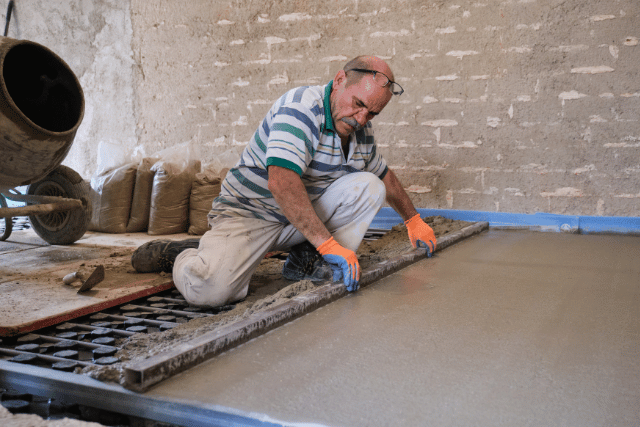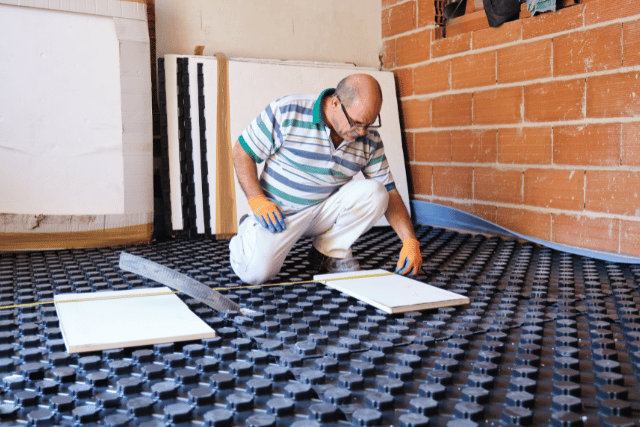Does Insulation Keep A House Cool During Summer? Written by: Energy Efficient You Published: 18th July 2024 Get in Touch Does Insulation …
Underfloor Insulation Grant
You could be one of the thousands of people eligible for free underfloor insulation Fill out our quick form to see if you qualify today.
At Energy efficient you, we’re here to help you improve your home’s energy efficiency by helping you get access to government grants for underfloor insulation.
Eligibility
Eligibility for Underfloor Insulation Grants:
This ECO4 underfloor insulation grant is a heating and insulation grant. Your property must also qualify for a heating upgrade or heating controls.
You can apply for a heating upgrade with underfloor insulation if the main heating of your property is a:
- Non-Condensing Boiler
- Back Boiler
- Oil Boiler
- LPG Boiler
- No heating at all
EPC rating of E, F or G and Benefit or Income criteria applies.
- No Gas Central Heating
- Electric Storage Heating or Electric Room Heaters
- Heating Controls (recommended on EPC)
- Electric Boiler
Grants For Underfloor Insulation
What Is Underfloor Insulation?
Underfloor Insulation is the process of adding insulation material beneath the floor to reduce heat loss or gain. This helps maintaining a comfortable indoor temperature, improving energy efficiency. It can also benefit heating or cooling costs. Underfloor insulation is important in buildings with suspended timber floors as these can be a significant source of heat loss.
The choice of underfloor heating insulation material depends on various factors such as the type of floor construction, budget, and climate conditions. Properly installed underfloor insulation can contribute to a more energy efficient home, reduced energy bills and enhanced overall comfort.
Eligibility For Underfloor Insulation Grant
Check Your Eligibility
Underfloor Insulation Grants
Insulation Underfloor
Common types of insulation materials used for insulation include:
- Fiberglass – Fine glass fibres and is available in rolls or batts.
- Rock Wool or Mineral Wool – Synthetic minerals such as basalt or slag.
- Polyurethane Foam – Available in spray foam form.
- Polystyrene Foam – Rigid boards or expanded beads.
- Reflective Foil Insulation – Reflective material that reflects heat.
Underfloor Heating Insulation
Underfloor Insulation Grant
Homeowners, Landlords and Private Tenants can lower the cost of fuel bills, improve the value of their home all with hassle free Loft, Cavity Wall, Internal or External insulation from Energy Efficient You Ltd.
Underfloor Insulation, when installed, takes the form of a sheet of solid insulation mounted right under the floorboards.
It helps to wipe out excess heat loss and the energy bill can be reduced at least 10%.
Moreover, underfloor insulation can be used collectively with reflective foil, however forming an insulated shield to counter the external atmosphere.
Insulating the floor will create a substantial difference in respect of power and cost savings. This can effectively be achieved by locating an insulating material beneath the floorboards and in between the joists, which as a result eliminates heat loss within the floor and towards the Earth. By doing so, nearly 15% of a house’s heat is lost. In addition to this, adding insulation to the floorboards also improves draughtproofing.
Free Underfloor Insulation Grants
FREE Underfloor Insulation
You could be one of the thousands of people eligible for FREE underfloor insulation for your home!
To find out simply fill out our eligibility form and we will get in touch with you to find out if you qualify.
We are improving energy efficiency in over 6,000 homes each week so you can be assured that our experience will give you confidence that this technical work is carried out competently and conscientiously.
Save on your energy bills, make your home energy efficient, reduce your carbon emissions, and increase the value of your home with a free underfloor insulation grant today!

Underfloor Heating Insulation UK
Underfloor Insulation UK
Proper installation is crucial to ensure the effectiveness of the insulation and to comply with building regulations.
Is Underfloor Insulation Worth It?
Benefits of Insulation Underfloor
The primary benefit of underfloor insulation is its contribution to improved energy efficiency. By reducing the heat transfer through the floor, this insulation helps to maintain a stable and consistent temperature.
As the insulation makes a building more energy efficient it also translates to lower energy consumption for homeowners making a positive impact on energy bills. Underfloor insulation can lead to reduced energy bills over time.
A well-insulated home with energy efficient features can increase the overall value of the property. Potential buyers are often attracted to homes with lower energy consumption and costs.
Another benefit of insulation underfloor is that it can contribute to noise reduction, reducing the transmission of sound between floors.
Underfloor Insulation Grants Frequently Asked Questions
Frequently Asked Questions
Yes! Check if you are eligible today!
Underfloor insulation is a good investment for your home. Not only will it help reduce your energy bills in the long term, but it will also add value to your property.
The placement of underfloor insulation depends on the type of floor construction in a building. Generally, underfloor insulation is installed in the space beneath the floor, providing a thermal barrier between the interior of the building and the area underneath.
Underfloor Heating Insulation Boards are made from various materials, each with different properties and benefits. Some common materials used in underfloor insulation boards include:
- Extruded Polystyrene (XPS) – This is well known for its strength, water resistance and excellent thermal performance.
- Expanded Polystyrene (EPS) – EPS is another type of foam board insulation but is less dense than XPS. EPS is lightweight and cost effective.
- Polyurethane (PU) Foam Boards – Available in rigid board form and provide good thermal efficiency.
- Phenolic Foam – Phenolic foam boards are also rigid and lightweight and offer high thermal efficiency.
- Fiberglass Board – Tightly packed fiberglass fibres bonded together, these are well known for resistance to moisture and pests. Also effective in reducing heat transfer.
- Cork Board – Natural renewable material that is less commonly used for insulation. This option is environmentally friendly.
- Plywood with Insulation Layer – Plywood sheets with an integrated insulation layer are used as underfloor insulation boards. These boards provide structural support as well as insulation.
- Reflective Foil Insulation Boards – Layer of reflective foil which is often laminated.
Yes, underfloor insulation is commonly used for wooden floors, particularly in buildings with suspended timber floors. The insulation is typically installed between the floor joists, which are the horizontal beams that support the floorboards. This helps create a thermal barrier, reducing heat transfer between the interior of the building and the space beneath the floor.

Grants For Underfloor Insulation
Government Backed Grants We Can Help With
Our Articles On Energy Efficiency
Learn More About Energy Efficiency
How To Keep Your Home Cool During Summer Written by: Energy Efficient You Published: 4th June 2024 Get in Touch How To Keep …
What Is A Back Boiler? Written by: Energy Efficient You Published: 16th May 2024 Get in Touch Back Boiler Heater Systems In …




